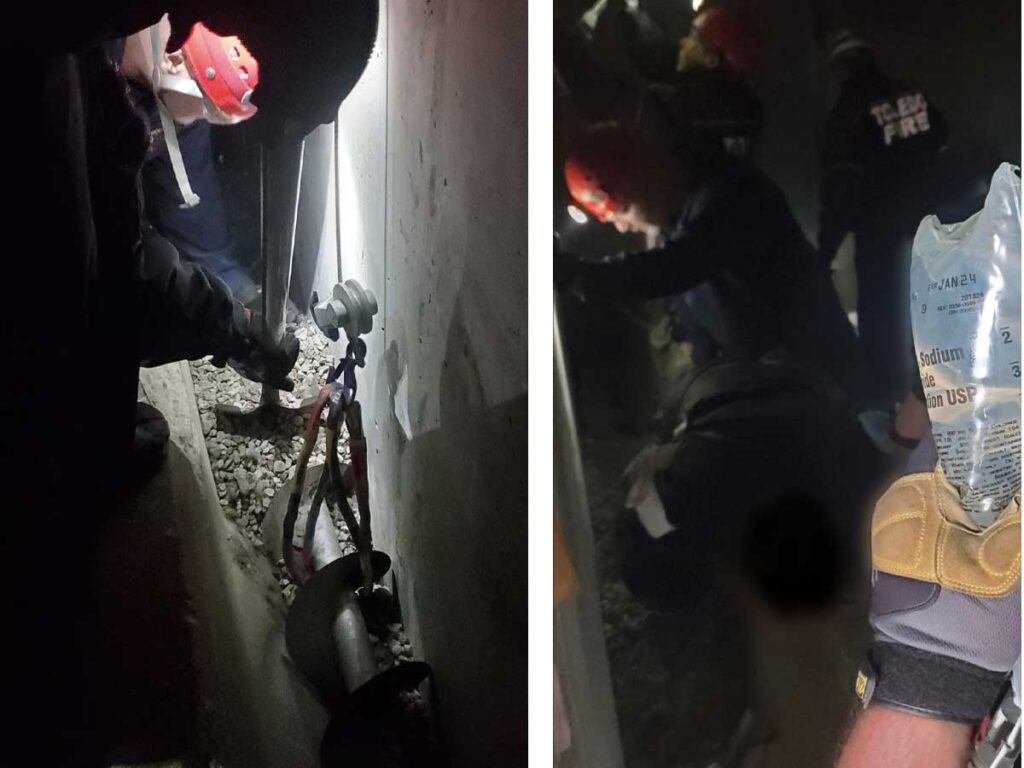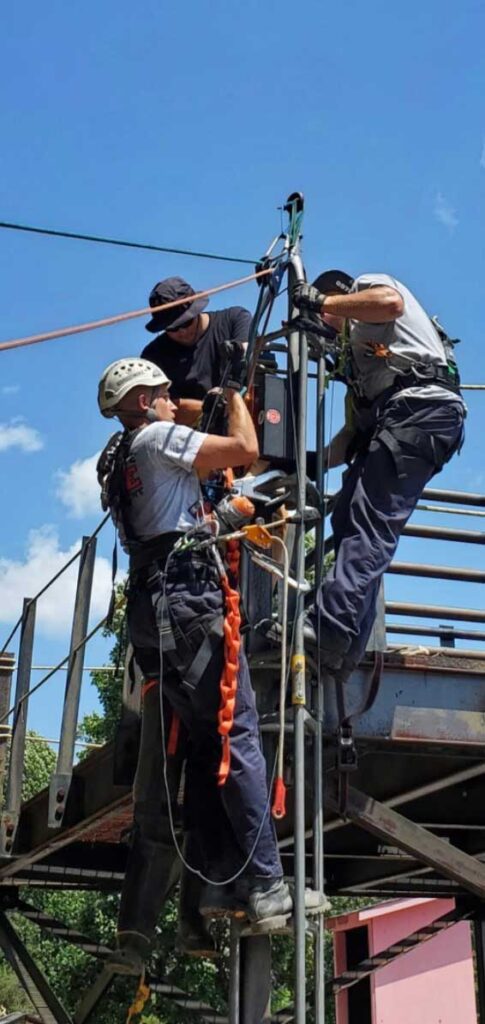By Jamie Morelock
Photos by author
Incidents involving the mechanical entrapment of an individual are a common occurrence. Machinery rescue incidents can occur almost anywhere, from the home kitchen to an industrial manufacturing plant. Many of these incidents can be easily mitigated by most fire departments using an understanding of mechanical devices coupled with basic hand and powered tools. However, a small percentage of these types of incidents require an advanced knowledge of machinery design and operation, along with specialized tools and equipment. Additionally, many of the advanced incidents require rescue personnel to employ other technical skills, such as rope or confined space access, to reach the work space.
Many agencies lump other extrication-type incidents into the machinery category. Incidents such as impalements are often included because the tools and techniques used for extricating a person from a machine are very similar.
Defining a Machinery Rescue
Most technical rescue disciplines share common nomenclature across the fire service. Machinery rescue seems to be the exception. To determine what incidents fall into the machinery rescue realm, we first must define the subject. When we analyze what incidents most fire departments consider a machinery rescue, we can arguably state they are “an incident involving the mechanical entrapment of a person by a simple or complex machine, either through the action of the machine itself and/or component of the machine.”
- Training Minutes: Rescuing a Victim from Auger Entrapment | Part 2
- Grain Bin Rescue: Are You Ready?
- Rescue Is Not Always Technical
- Tech Rescue and Common Sense
Types of Machinery Rescue Incidents
Now that we’ve defined what constitutes a machinery rescue, we can then divide incidents involving machine entrapment into three categories. Impingements, entanglements, and impalements make up machinery rescue categories by defining the action by which the victim is entrapped. Each category has unique requirements to bring about a solution.
Impingements
Impingements involve a body part of the victim being trapped by component of a machine under pressure. The degree of victim injury will depend on the amount of force applied through the component. Some impingement accidents are minor and the victim is relatively uninjured, only stuck. Other impingements may crush the body part, resulting in a high degree of mortality and the need for advanced medical intervention before releasing the victim.
Entanglements
Entanglements involve a victim being trapped by a product of the manufacturing process. This could be thread, wire, or ribbons made from any number of materials. Entanglements also include the victim becoming trapped by an article of clothing that is wrapped into a moving component of the machine. The degree of injury is dependent on several factors, such as the speed of the moving component, the force of the moving component, the type of machine operation, and the depth to which the victim is pulled into the machine operation.
Impalements
Impalements are when a component of a machine or other object pierce the victim. It is often difficult to determine the degree of victim injury due to our inability to see what internal organ systems have been damaged. Release from an impalement can be accomplished on scene by reducing the impaling object down to a manageable size so that victim transport to a trauma center can be made. Only a physician should attempt to remove an impaled object.
Many complex machinery rescue operations may include more than one type of entrapment category. Developing a systematic plan-of-action for extrication will increase firefighters’ likelihood of success.

Methods of Releasing a Victim
There are three methods for releasing a victim trapped by in a piece of machinery. Firefighters must consider several factors when determining a method: How and where the victim is trapped, rescue versus recovery, and the medical condition of the victim. A thorough size-up will best determine which extrication method to employ.
Disassembly
Disassembly is the preferred method for most machinery extrications. Machine components are removed in the reverse order that the machine was originally assembled to gain access and free the patient. Hand tools are the primary choice for this method. Standard wrenches, of both metric and imperial sizes, should be carried on rescue apparatus. The most common wrench sizes used for industrial type machinery included the ¾-, 15/16-, and 1 1/8-inch. It is best practice to carry two complete sets of combination (open-end/box-end) style wrenches in sizes from 3/8- to 1 ¼-inch. Matching “shallow well” and “deep well” socket/rachet sets should complement the wrench sets. It is strongly recommended to use impact-type sockets, whose design will withstand use on pneumatic and electric impact drivers. Multiple, high-quality screwdrivers, hex key (Allen) wrenches or sockets, hammer(s), drift/punches, and pry bars should also be included in your tool cache. Some industries will have fastener sizes beyond what is normally carried by rescue units. In these cases, on-site maintenance personnel typically will have tools for these specific machine components.
The disassembly method of extrication offers the highest degree of control when removing components from a machine. Additionally, it will allow for the machinery to be placed back in-service more efficiently following the extrication operation and accident investigation.
Destruction
The destruction method of extrication uses techniques such as spreading or cutting to deform and/or remove components of a machine to facilitate sufficient space for access and removal of a victim. Typically, the tools used for the destruction method fall into the cutting, burning, and spreading categories. Many components are under tension or compression. When using these tools to displace or dismantle a piece of machinery, it is imperative to capture all progress made to prevent further victim injuries if crews were to lose control of the component being displaced or removed. Also, many of the tools used for the destruction method generate heat and sparks. Victims will need to be shielded from both, as well as inadvertent contact by a flame or cutting edge.
Destruction is the method of choice when speed of extrication is needed. If a victim is in poor or declining medical condition, the destruction method would be most appropriate. Other times that destruction will be required is when there are no fasteners accessible to remove a component of the machine.
Reduction
Reduction is a hybrid extrication method. It incorporates disassembly and destruction techniques to reduce the overall size and weight of the machine or component into a manageable package. With reduction, the victim is still trapped, but is “mobile.” The victim is packaged and transported to a trauma center, where rescue personnel will complete extrication alongside medical personnel and physicians. Definitive care beyond what is capable in the field will determine when the reduction method is used.



Energy Control
Control of electrical, stored energy and the effects of gravity are required to prevent further injury to the victim or rescue personnel. Energy control is progressive. Initially, stabilization should be accomplished to prevent further movement of components. Typically, this is done by chocking with standard or modified extrication wooden blocks and wedges. The coefficient-of-friction (C-o-F) between the chocking piece and the machine component must be high enough to prevent the chock from slipping free. For this reason, chocking alone is not sufficient for positive control and stabilization.
To further control unintended movement, all types of energy must be captured. When the energy provides machine power in the form of electrical, pneumatic, or fluid transfer, lockout-tagout of the source will be needed. Machine control switches, found near the machine, may provide an immediate stop of power, but they do not provide the appropriate level of control required. Alternatively, the power source can be detached from the machine when it cannot be locked out at the source.
Other means of capturing and controlling energy that is created by gravity or from elastic energy (springs) can be accomplished via rigging. Rigging methods vary and offer a wide range of options to rescuers to prevent the further movement of machine components. Prior to any rigging operation, a load assessment must be calculated. Rigging can be then used to carry the load from movement, usually from overhead, or opposing rigging systems can provide counterforce to hold the load stationary.
Rescuer Safety
Rescuer safety is of the utmost importance when conducting machinery operations. Energy control prior to conducting any rescue method is a high priority; this includes lockout-tagout. Standard firefighting personal protective equipment (PPE) is not the most appropriate clothing for firefighters to use for this type of rescue. Most structural fire gear is too bulky to perform the fine motor skills needed and prevents access into the small spaces routinely encountered in machinery. Additionally, contrary to popular belief, turnouts do not hold up well to cutting and burning operations. Flame-resistant-type clothing used in the welding industry provides some of the best protection for rescue workers. Lightweight leather gloves provide cut, abrasion, and heat protection. Eye and often respiratory protection are an absolute necessity. Ear plugs protect hearing, improve communications in high-noise environments, and help prevent hot sparks or cutting slag from entering the ear canal.
Do not underestimate the amount of biohazard, grease, oils, and chemicals that may be present during a machine rescue operation. Consider setting up a DECON station outside the hot zone. Hazmat PPE may be needed to reduce blood-borne pathogens from contacting rescuers. EMS-type gloves and hazmat coveralls can be worn underneath FR PPE.
*
Incidents involving machinery entrapment can only be safely mitigated when rescuers have mechanical aptitude, proper training, and the right tools. Machinery rescue goes beyond the skills acquired from a standard vehicle extrication course. Fire personnel with prior experience as millwrights or in industrial maintenance can be a wealth of knowledge on machinery construction and operations. Applying the concepts included in this article can help build a solid foundation of knowledge and prepare rescue personnel when they encounter their next machinery rescue incident.

